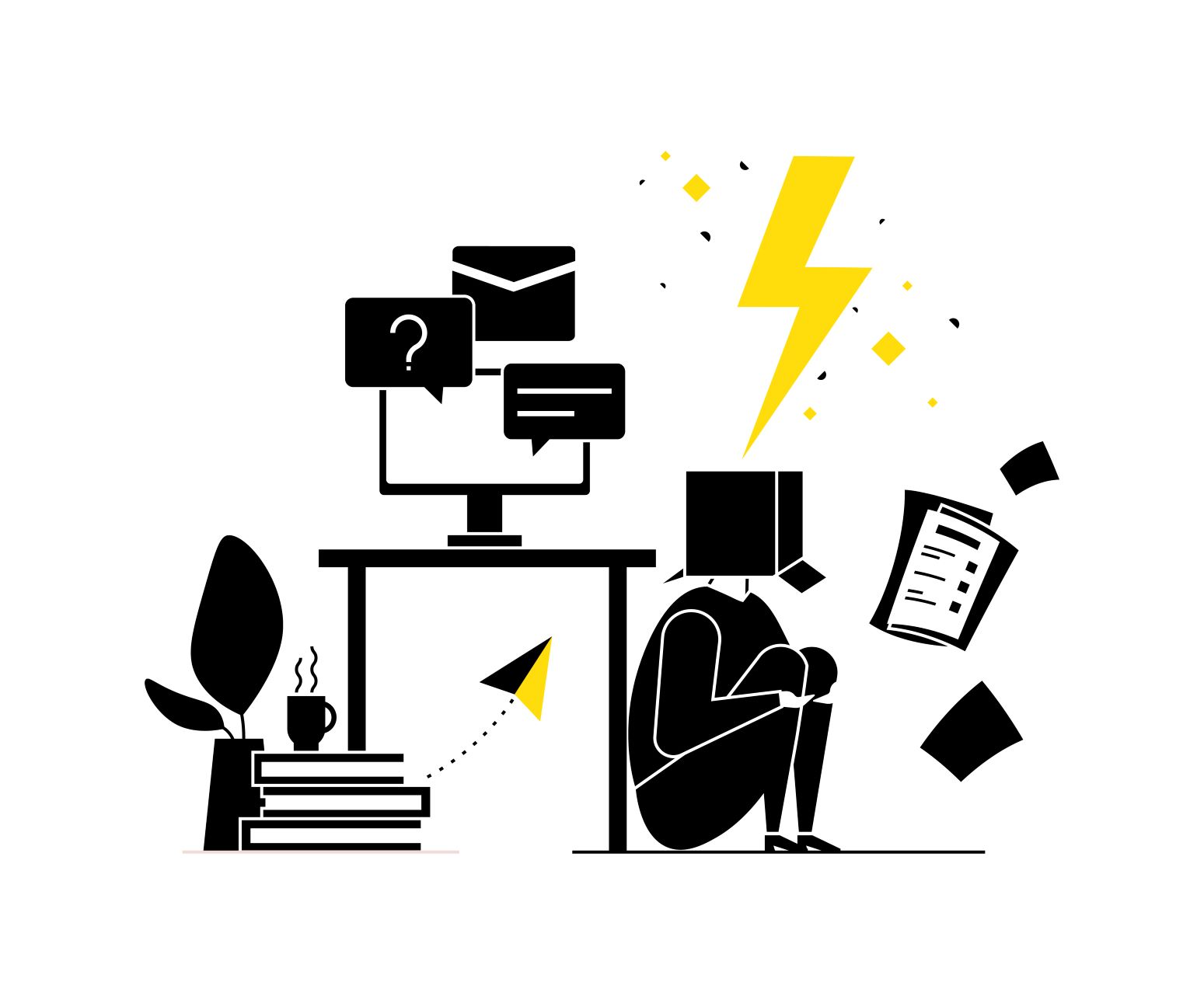Feeling the Burn
Robin Walters | June 16th, 2021

Burnout is Real: Let's Fix IT
It’s in the ICD-11, which is the manual on diseases that your healthcare professional uses to classify medical or other health hazards. The IDC-11 defines burnout as “an occupational phenomenon,” not a medical condition. That means U.S. employers should pay attention to burnout as work-related hazard, like carpal tunnel or running over your foot with a forklift. About a quarter of American adults say they’re burned out at least some of the time. The issue seems to be worse in the tech field; a poll of 11,000 tech workers showed closer to 60% were feeling burned out.
Occupational burnout is an issue that no employer wants to have happen. It’s a significant contributor to employee turnover at a time when we need every bit of technology expertise we can find. Blame COVID or intense production driven environments, but no matter the cause, burnout is costing American employers somewhere between $125 to $190 billion annually.
Are you feeling the burn? What are the signs? I spoke with some of my AWH colleagues to find out if and how they experienced burnout in their professional programming careers. What can employers do to take better care of their people and keep them from sizzling their way into a smoking ash pile?
If You’re Not Burning, You Can’t Burnout
A senior advisor at the Limeade Institute makes a really good point: Burnout doesn’t happen to the disengaged. She says, “You have to be on fire in order to burnout.” Nate, one of the developers at AWH, agrees with this statement. He’s experienced burnout in the past and describes it as, “Feeling like you can never turn off, relax, or feel refreshed, even when you are not working.”
It seems like fatigue and exhaustion would be an inevitable result of not being able to hit the off button. I mean, even Duracell batteries fizzle out eventually, right? (I never liked that noisy bunny, anyway.) For people, this leads to common symptoms that Nate describes as, “A sense of being overwhelmed, irritation, fatigue, anxiety, or depression, physical tension, and dread.”
People that love their work burnout all the time. You can go into the job and be highly productive—at least for a while. HR Exchange Network says, “Over time, however, these workers may lack the personal skills to maintain their wellbeing. Without organizational support, that can quickly transform into burnout.”
Why Are Developers More Prone to Burnout?
When developers are hot to code, you can smell the ozone burning. Writing code is an intense creative process that requires all of your brain synapses to fire. But problems arise when you move beyond the line of code and start to look at the bigger picture of how everything fits together. Building software is hellaciously complicated. To do it well you have to take small bites of the elephant. Otherwise, you’ll get stepped on.
Tommy, a Senior Developer who’s been with AWH for more than eight years, has felt the sting of being overwhelmed by the scope of a project. He describes it as:
“I struggled a lot and felt burned out when I was supposed to figure out how to configure for local development and then run a product system locally that used a bunch of unfamiliar libraries and build processes and steps, with an unfamiliar language as its primary language, with what seemed like 30 different configuration files in the project, with more nested in components of the project, which there were about a dozen of, and which I didn't understand the purpose of or order of usage.”
I have no clue what he’s talking about technically. But I can sense the agony he went through just from reading the sentence. That’s an 86-word one-sentence paragraph that was ultimately caused by just one development task.
It’s no wonder our developers are vulnerable to burnout. Nate says, “Software projects sometimes feel like you have an unlimited mountain of work in front of you.”
It’s obvious from Tommy’s story that he felt committed to figuring out the task. Of course, our highly engaged A-player knowledge workers are all in—we expect nothing less from them. But it’s a two-way street; employers have a responsibility to protect our teams from burning out.
In my opinion, there are two things we can do right now to head off tech worker burnout:
- It’s the responsibility of the employee to be aware of when they feel overwhelmed and then practice self-care to stave off burnout symptoms.
- But it’s also the responsibility of the employer, to make accommodations for their employees so they don’t burnout.
What does that look like exactly?
Extinguishing Burnout in the Tech Field
If you’re reading this, my guess is you may be experiencing some of your own burnout symptoms. I mean, 2020 was enough to burn most of us out, am I right?
Sometimes the best answer for highly engaged tech workers experiencing burnout symptoms is to take what Stephen King describes in his excellent book Duma Key as “a geographical.” Meaning, a change of scene may be in order. Maybe you need time off. Maybe you need a new job. The key to this is the realization that you’re struggling. Recognizing your stress is, of course, the first step toward alleviating it.
Another AWH Developer, Shabnam is fairly new to the field, but she’s already felt the burn starting. The difference is that she is also self-aware enough to recognize it when it started to happen. She says:
“I've found that I'm most productive when I'm not stressed, so if I was starting to feel overwhelmed I would recognize that feeling, set an alarm for 5-10 minutes, and step away from my computer to just close my eyes or take a walk. I like to set out goals for myself every day. So, when I complete a task or close out a ticket it feels like a little win and that keeps me motivated. Also working from home has made it easy to take breaks whenever I need a refresh so I can get back into work mode with clear head.”
Shabnam is on to something here. She’s self-monitoring in a way that protects her from experiencing too much stress. When you’re working from home this is particularly important because you can’t turn to a coworker to blow off steam. Talking to other developers in a collaborative work environment is a good way to keep the job fun and alleviate frustration.
At home, it’s all you and the task you’ve set in front of yourself. So, you have to take time to engage in self-care every day to keep from becoming a crispy critter.
Remote work presents issues for employers striving to create a culture of wellness for their tech teams. But the reality is many of the issues that caused employee burnout were happening well before remote became the new normal:
- Heavy workloads
- Failing to work smarter
- Not enough time to accomplish assigned tasks in an eight-hour day
- A lack of organizational support
- A culture where going above and beyond is the expectation
To protect their IT teams from burnout, employers should take a page from land developers who use the phrase “highest and best use” to maximize their real estate investment. This phrase can be applied to how infrastructures and workflows are organized in IT teams or on IT projects. Highest and best use of your staff on an IT project at AWH means that we focus our developers on one thing—writing the best quality code they can. We have BAs to pull requirements, testers to pick apart the features, and project managers to run the whole shebang. Making developers run in too many directions causes burnout. I’ve seen it happen.
Companies should also make wellness an active part of their culture, whether their employees are home or in an office. This includes more than just physical health. Engaging in discussions around mental health will improve employee experience and mitigate the risk of burnout later. Here’s some good news, employers: For every dollar spent on workforce wellness programs, medical costs drop by $3.27; that’s a 6:1 return on the investment.
Of course, there are also wellness apps to alleviate burnout; Mindfulness apps like Headspace and Exhale, food and dieting apps like Noom, and meditation apps like Meditopia. There are apps to help you quit smoking and wearables to keep you moving. But are apps the answer when a company culture emphasizes the stress of more output, longer hours, and more production?
As we sheltered in place in 2020, most of us lived our lives online. Where we worked, what entertained us, and how we socialized all crammed together into a big or small screen. This fuzzed out the separation between work, home, and our personal lives. Before COVID, there were natural pauses all day long for the commute, coffee runs, and hallway chats. Now, if we don’t police ourselves, we spend way too many hours working without even standing up.
I’ll leave you with a controversial statement to consider. Maybe the answer to preventing burnout isn’t in a screen at all. Taking a break from the digital environment may be just exactly what the doctor ordered. Good luck, and take care of yourselves!
